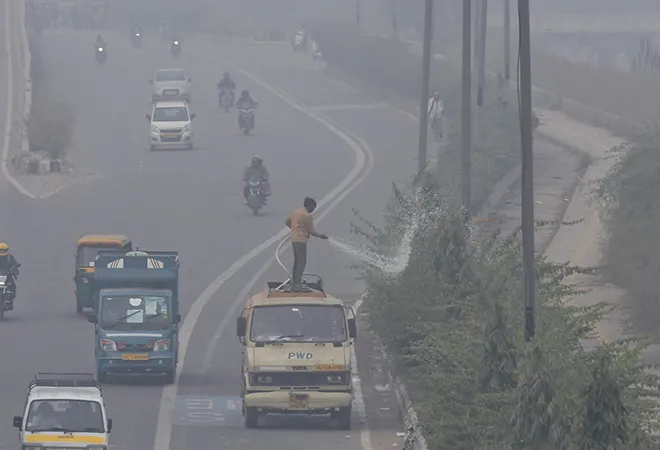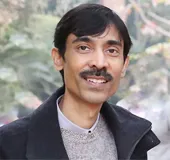-
CENTRES
Progammes & Centres
Location
Despite the Delhi government’s efforts to improve the air quality, a thick layer of smog continues to shroud Delhi

Every year during the winter months from October to February, the topic of air pollution in Delhi makes news headlines. This happens because air pollution reaches alarming levels during this period, and there are notable adverse effects of poor air quality on the economy, environment, and people’s health.
In October 2022, several areas of Delhi recorded Air Quality Index (AQI) values of over 400 which is indicative of poor or ‘severe’ air quality. Air is considered ‘good’ only when the values lie between zero and 50.
Although the causes for deterioration in air quality are sufficiently understood by the city government, their responses are not showing encouraging results. Though there is marginal improvement in air quality due to government intervention, however, maintaining progress in this regard has been challenging. Unfortunately, much of the efforts and resources allocated for solving this problem are going to waste.
During the winter season, the weather conditions are such that dust and emissions generated from various activities get trapped in the lower atmosphere thus raising the level of air pollution.
This article describes why air pollution levels escalate in Delhi during winter months, and what difficulties are being experienced in addressing the issue.
Winter weather conditions in Delhi are ideal for the accumulation of air pollution. By October, the rainy season ends, temperature and humidity begin to drop, wind velocity reduces, and there is lesser number of sunny days. Round the year, many pollution-generating activities are carried out, such as those related to the management of solid waste, transport, industry, construction, and agriculture sectors. However, during the winter season, the weather conditions are such that dust and emissions generated from various activities get trapped in the lower atmosphere thus raising the level of air pollution. For most days, the colour of the sky is grey, visibility is poor, and there is a strong presence of smoke and dust particles in the air which makes breathing difficult. Often, Delhi is referred to as a “gas chamber” during this period.
When air quality deteriorates beyond a certain level, a Graded Response Action Plan (GRAP) is applied in the city. It offers a set of measures aimed at combating air pollution. Some of these include a ban on entry of diesel-fuelled trucks in the national capital, restrictions on private car usage (i.e. introduction of odd-even number plate method), halt of construction and industrial activity, the closure of schools, the introduction of a work-from-home model, etc. Further, anti-smog machines are deployed for spraying water at various locations in the city.
Although the sale and bursting of firecrackers, including green ones, is banned in Delhi to control air and noise pollution, this activity could not be prevented by law enforcement agencies.
There are also times when air pollution reduces substantially due to sudden changes in the weather, such as fast-blowing winds or the occurrence of rainfall. This is, however, a temporary period of respite for the government. A couple of irregularities on the part of the government as well as citizens can be studied.
The first concern is the bursting of crackers during Diwali. In October 2022, air quality deteriorated immensely after the Diwali celebrations. Its impact was seen in the form of heavy smog and reduced visibility that lasted for several days. Although the sale and bursting of firecrackers, including green ones, is banned in Delhi to control air and noise pollution, this activity could not be prevented by law enforcement agencies.
However, something needs to be done in this respect. Stricter monitoring and enforcement of the law by authorities, and spreading greater awareness about the harmful effects of air and noise pollution particularly among the younger generation could be useful in the long run. Such measures might lead to the discontinuation of the existing practice of bursting firecrackers.
Secondly, farmers in neighbouring states of Haryana, Punjab, and Uttar Pradesh follow a practice of burning crop residue after harvest. This helps to clear farmlands for sowing the next crop.
When the residue is burnt in farmlands around Delhi, the smoke produced is trapped in the lower atmosphere due to weather conditions and spread by winds in the national capital region. This year too similar conditions were witnessed which led to a fall in visibility and a strong smell of smoke in the air.
The many policies and plans drawn by concerned state governments to address the issue have largely remained on paper such as “climate resilience building among farmers through crop residue management”.
When the residue is burnt in farmlands around Delhi, the smoke produced is trapped in the lower atmosphere due to weather conditions and spread by winds in the national capital region.
The prevailing conditions call for proper directions and adequate support to farmers for better disposal of residue. Instead of asking farmers to buy straw management machines at subsidised rates, which involves further investment by farmers to run the machines, management centres for collection, and processing/disposal of crop residue could be established at the block level.
Management of solid waste is the third area of concern. Delhi’s population has grown to over 20 million and high consumption patterns have resulted in the generation of huge quantities of solid waste. It is learnt that over 12,000 tonnes of waste is generated daily.
For long, the Municipal Corporation of Delhi—a waste management agency—collected and dumped unsegregated waste in sanitary landfill sites situated at three different locations in the city, namely Bhalswa, Ghazipur, and Okhla. Due to continuous dumping over the years, the three sites are oversaturated to the point that these give the appearance of a hill from a distance; some are up to 65 metres (or over 200 feet) high. The worrying part of this practice is the extremely unhygienic conditions at these sites and instances of burning due to “methane gas generation from the decomposition process of garbage.” This is harming the health of poor communities living in nearby areas.
The waste agency in partnership with civil society organisations has been making efforts to address the issue, such as enforcing the practice of waste segregation at source, in-situ waste processing, use of waste-to-energy plants, compost plants, and engineered sanitary landfill. However, the problem remains.
Due to continuous dumping over the years, the three sites are oversaturated to the point that these give the appearance of a hill from a distance; some are up to 65 metres (or over 200 feet) high.
Somehow the mountains of waste created at existing landfill sites need to be cleared. This would require transferring the waste to natural depressions on the surface of the land and ensuring that the transferred waste does not harm the environment and groundwater. Further, the municipality must ensure zero dumping of waste in existing sites.
Motor vehicle ownership in Delhi is huge. The city has about 8 million active registered vehicles. Most of these comprise private two-wheelers, cars, and goods carriers. Further, a large number of vehicles enter and exit Delhi on a daily basis. People from Delhi and neighbouring cities (namely Faridabad, Ghaziabad, Gurugram, and NOIDA) commute in either direction for various purposes.
This pattern of travel creates immense pressure on city roads. It also leads to a polluted environment as almost all vehicles run on some type of fossil fuel. An air pollution source apportionment study reveals that the transport sector contributes significantly to the total emission.
Several steps have been taken by the government to minimise vehicular emissions, such as the switchover of public transport vehicles to compressed natural gas, shift to cleaner fuels, levy of environment compensation charge on diesel vehicles entering the city, phasing out of old vehicles, development of metro rail services, etc. Although some benefits have been derived from the measures, it is realised that the burning of fossil fuels has to be reduced.
A national initiative underway is the scheme for faster adoption and manufacturing of electric vehicles (EVs). Since its implementation in 2015, the number of EVs in Delhi has grown to nearly 200,000. Most of the growth is observed in the two- and three-wheeler vehicle category. Unfortunately, a large population continues to remain inclined towards conventional (fossil fuel-based) vehicles due to unfamiliarity with EV technology, high upfront cost, inadequate charging infrastructure, and safety concerns.
Several steps have been taken by the government to minimise vehicular emissions, such as the switchover of public transport vehicles to compressed natural gas, shift to cleaner fuels, levy of environment compensation charge on diesel vehicles entering the city, phasing out of old vehicles, development of metro rail services, etc.
To conclude, Delhi is recording high levels of air pollution, particularly during winter months. The problem occurs because of improper conduct of various human activities such as the bursting of firecrackers, burning of crop residue, solid waste and fossil fuels, and violations in construction and industrial sectors. Natural factors such as rain, humidity, temperature, and wind, also play an important role in limiting and augmenting air pollution.
The phenomenon is affecting the population living in Delhi and neighbouring areas. During this period, students are unable to go to school, workers resort to working from home, and construction and trading activities are severely disrupted. Ensuring proper conduct of human activities is key to addressing the issue of air pollution.
The views expressed above belong to the author(s). ORF research and analyses now available on Telegram! Click here to access our curated content — blogs, longforms and interviews.

Rumi Aijaz is Senior Fellow at ORF where he is responsible for the conduct of the Urban Policy Research Initiative. He conceived and designed the ...
Read More +